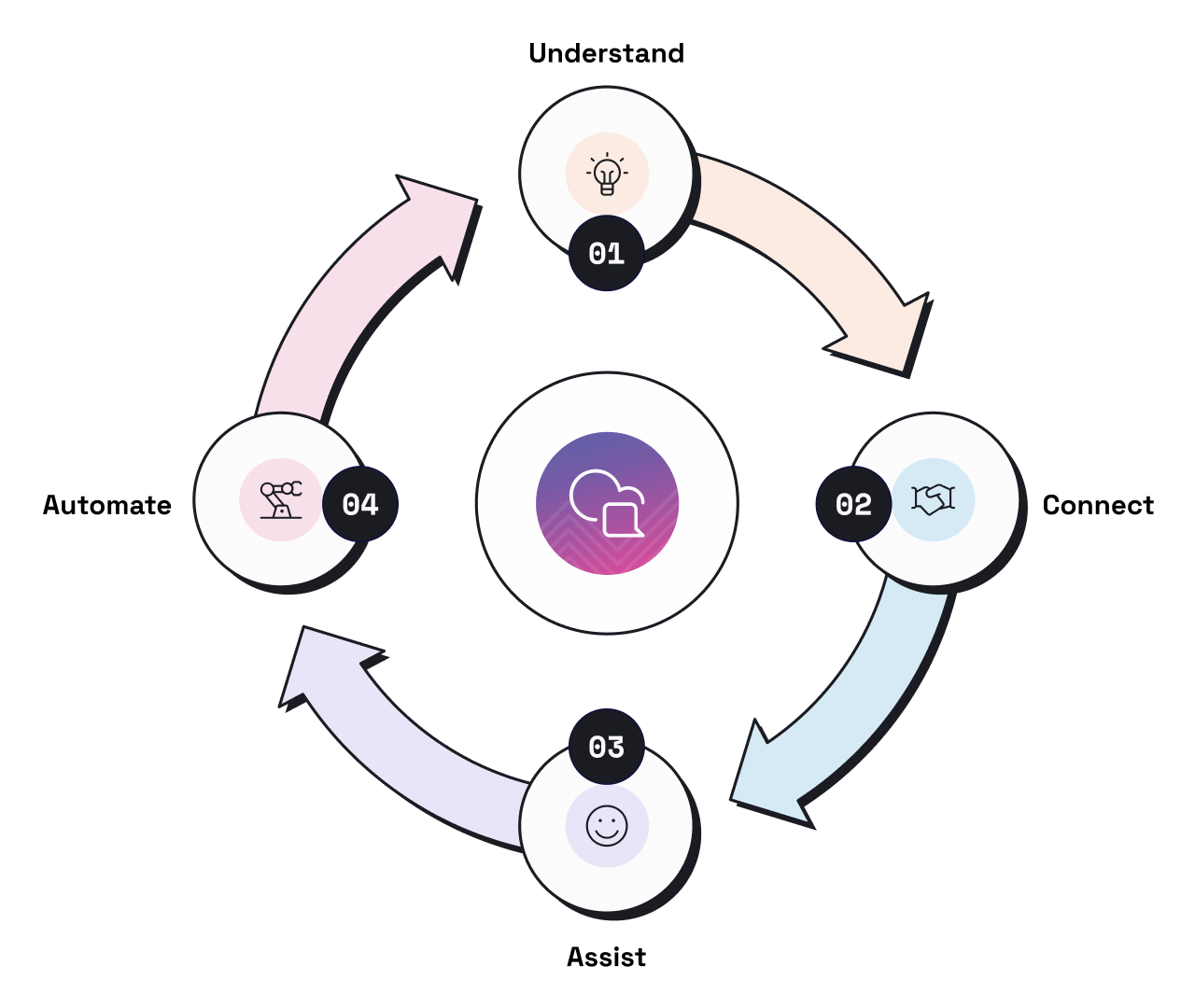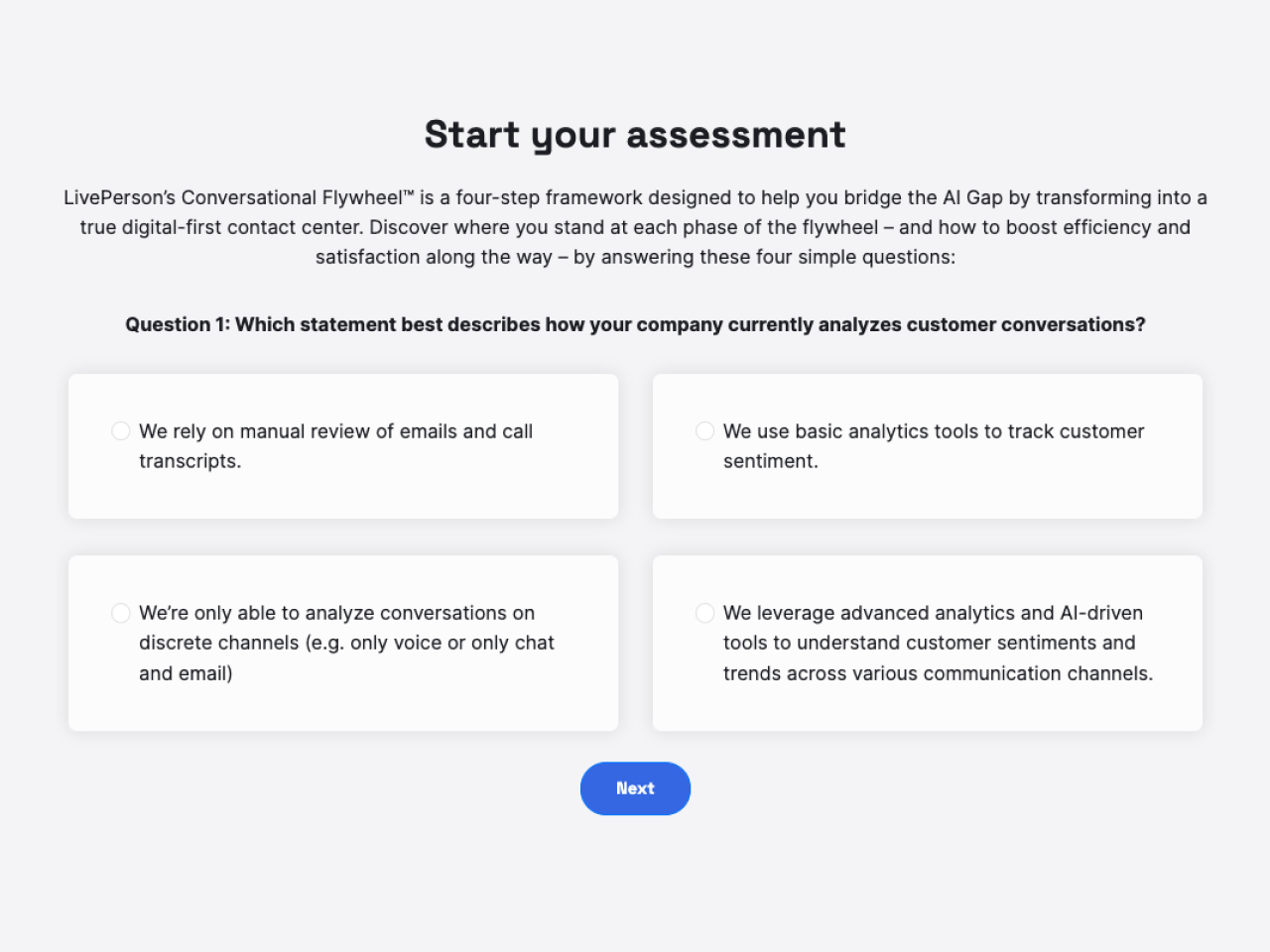GuideEnterprise guide to digital transformation solutions
This guide will break down digital transformation solutions, offering insights, strategies, and practical advice to empower businesses to navigate their transformative journey. Ready to thrive in the digital age with confidence and clarity? Scroll down and step into the future.

A digital business imperative
In the realm of business, FOMO has always been a looming motivator — but it’s never been more pertinent than right now. With technology advancing at a rate we’ve never seen before, the adoption of AI technology is no longer a far-off futuristic pipedream. These innovations are the currency of success and your business’s key to survival — but where do you even begin when there’s so much noise?
The answer? Digital transformation solutions.
While these words may conjure up imagery of an intense, ambiguous, and expensive process, that couldn’t be further from the truth. Digital transformation is a revolution that you should be getting excited about. It gives you the opportunity to harness the power of technology to reshape operations, enhance customer experiences, and continue driving growth.
At its core, successful digital transformation often transcends mere technological upgrades — it embodies a cultural shift, a strategic imperative, and a relentless pursuit of innovation. There are boundless initiatives you can try — from adopting cutting-edge technologies like artificial intelligence and automation to reimagining business models, processes, and customer interactions. But as thrilling as digital transformation is, it comes with challenges — from legacy systems and organizational inertia to talent shortages and cybersecurity threats. Let’s get prepared.
See how LivePerson can help
What is digital transformation?
Digital transformation is the strategic integration of digital technology into all aspects of a business, fundamentally changing how it operates and delivers value to customers. It’s more than adopting new technologies — it’s examining your business through a critical lens that allows it to thrive in the digital age. At its core, the digital transformation journey is about innovation and adaptation, driven by the imperative to stay competitive in an increasingly digital world.

From cloud computing and artificial intelligence to data analytics and automation, digital tools empower organizations to make smarter decisions, anticipate customer needs, and deliver personalized experiences at scale. For instance, conversational AI platforms like LivePerson enable businesses to engage customers in real-time conversations across various digital channels, providing instant support, personalized recommendations, and seamless transactions.

Essentially, digital transformation is a passport to future success. It fosters agility and responsiveness, enabling businesses to adapt to market changes and capitalize on emerging opportunities quickly. By embracing digital innovation, organizations can break down silos, foster collaboration, and create a culture of continuous improvement. Ultimately, digital transformation isn’t just about surviving in the digital age — it’s about thriving and shaping the future of business through innovation, efficiency, and customer-centricity.
Digital transformation solutions in action
It can be hard to imagine the impact that digital transformation strategies can have in holistic, practical terms. We’ve got some real-world examples of how a robust digital transformation strategy can overhaul specific industries and work in certain use cases.
Retail: The RealReal
The RealReal is committed to creating a customer experience as luxurious as their brand. Working with LivePerson, The RealReal leveraged conversation intelligence tools to better understand the cosigner experience and make digital transformation improvements to their service. With new messaging channels and automation, they were able to increase CSAT by 10%. Read their story

Banking: Capitec
How does a bank keep up with customer needs 24/7? Digital transformation through Conversational AI. Using a messaging-first approach, service agents can meet customers when and where it’s convenient for them. Additionally, agent-facing generative AI tools have helped double their efficiency, leading to a 79% CSAT. Read their story

Wholesale: Mouser Electronics
As part of their digital transformation, Mouser worked with LivePerson to expand their customer engagement to digital channels, including one of the most important for APAC customers, WeChat. Messaging was paramount to helping their customer service teams keep up with demand (they handle over 250,000 conversations annually). Read their story

Energy: EDF
EDF’s digital transformation initiatives included enhancing customer experiences with digital technologies and fostering a more sustainable energy ecosystem. Working with LivePerson, EDF was able to better understand customer intents, connect on more digital channels, and automate frequent requests to reduce wait times. Read their story

6 simple steps:
Your cheat sheet to introducing successful digital transformation

Step 1:
Conduct a digital readiness assessment
Assess your organization’s current digital capabilities, identify areas for improvement, and prioritize digital transformation initiatives based on your business goals, strategic objectives and resource constraints. Put your digital capabilities to the test with our maturity assessment tool.

Step 2:
Develop a comprehensive digital strategy
Define a clear roadmap for the digital transformation initiative, outlining goals, timelines, key milestones, and success metrics. Ensure alignment with business priorities and secure buy-in from stakeholders across the organization.

Step 3:
Start with small wins
Don’t get overwhelmed! Start with pilot projects or proof-of-concepts to demonstrate the business-value side of digital transformation initiatives and build momentum. Focus on quick wins that deliver tangible business outcomes and generate enthusiasm among employees.

Step 4:
Promote change management
Implement robust change management processes to manage resistance, address cultural barriers, and ensure smooth adoption of digital technologies. Communicate the benefits of digital transformation, provide training and support to embrace digital transformation, and empower employees to embrace change.

Step 5:
Collaborate with external partners
Seek partnerships with external vendors, technology providers, and industry experts to leverage their expertise, resources, and capabilities in driving digital transformation initiatives across many organizations. Collaborate with trusted partners to accelerate implementation, mitigate risks, and maximize ROI. Resources like LivePerson’s LP 360 are available to help brands accelerate their digital transformation with end-to-end enterprise-managed contact center services.

Step 6:
Monitor progress and iterate
Monitor and evaluate the progress of digital transformation projects and initiatives against established goals and KPIs. Solicit feedback from stakeholders, iterate on strategies as needed, and adapt to changing market conditions to ensure the success of digital transformation efforts.
Future-proof your enterprise
Digital transformation is crucial for businesses to stay competitive, innovate, and thrive in the modern marketplace. By leveraging digital technologies to enhance operational efficiency, improve customer experiences, and gain a competitive advantage, businesses can adapt to evolving market dynamics, drive growth, and future-proof their operations. In essence, digital transformation is not just a strategic imperative; it’s a pathway to sustainable success in the digital age.
Check out LivePerson’s blueprint for digital transformation







